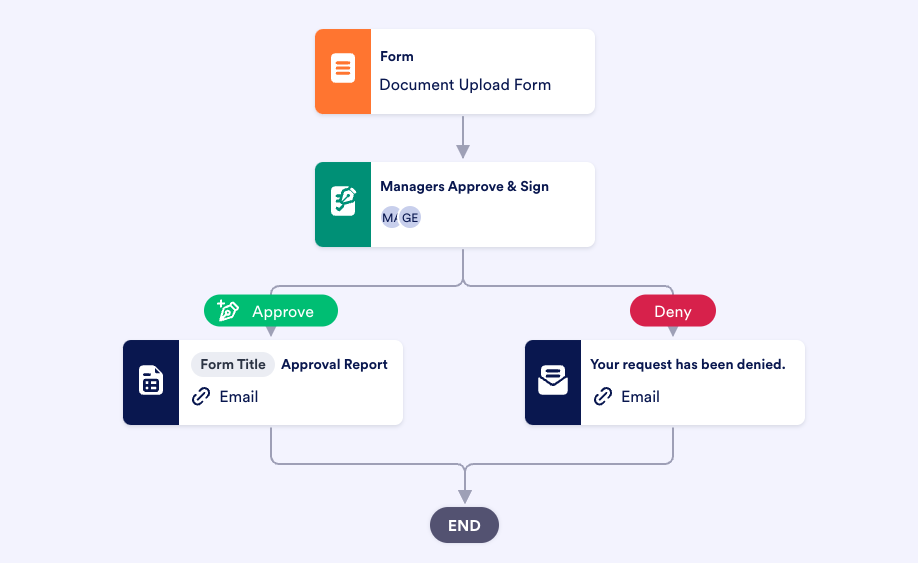Every business runs on processes. Whether it’s a bakery offering trendy cupcakes or a software development firm making social media apps, businesses need processes to keep things moving.
When employees have a clear set of processes in place, they can effectively work on their tasks and help the business achieve its goals. Managing those processes is an important part of running a successful organization.
What is process management exactly, and why does it matter? In this article, we cover that and more, including examples of different processes and what to look for in process management software.
What is process management, and why is it important?
Process management, sometimes referred to as business process management (BPM) is a methodology used to align the processes of a business with its strategic goals. Process management has several phases: planning, designing, modeling, implementing, analyzing, and optimizing.
These phases sometimes have different titles, and certain phases may be combined under certain models. However, the overall method of process management remains the same: Organizations plan and design processes based on the business’ strategic goals and then create and implement them in the workplace while monitoring and adjusting them as required.
Without effective process management, an organization may not be able to achieve its strategic objectives. Process management keeps the organization on track to reach its goals and ensures no process is redundant, unproductive, or unnecessary.
“It’s not possible for organizations to put processes around every single thing,” says Matthew W. Burr, owner of Burr Consulting, LLC, a strategic human resources consulting firm. “However, they should be looking at day-to-day operations and things that happen on a recurring basis and put processes around those items.”
Using process management is good for business because it stimulates
- A culture of optimization: With process management in place, employees see the value in improving processes. They’re always looking for ways to make things more effective.
- High productivity: Continuously working to remove bottlenecks, minimize delays, and calculate the risks of certain processes helps make an organization more productive.
- Agility and flexibility: When companies use process management, they know how to quickly change processes to adapt to new conditions. If there are changes in consumer or market behavior, for example, employees can easily switch tactics.
- Employee engagement: A part of process management includes automating certain tasks or removing repetitive steps within tasks. Doing so allows employees to focus on tasks that add greater value to the business.
- Accuracy and timeliness: Effective process management minimizes miscommunication, missed deadlines, and errors. As a result, the organization improves the quality of work produced as well as its ability to deliver products or services on schedule.
What are some examples of process management?
Any department in a business has its own processes. Processes can be internal only (involving only employees) or both internal and external (involving both employees and customers). In some businesses, processes are external only (involving only customers or vendors).
“If employees have suggestions for ways to improve processes, organizations need to be open to incorporating feedback,” says Burr. “Organizations don’t always have processes that make sense, so there is always room to make things better.”
Here are some examples of different types of processes that businesses can optimize using process management:
- Employee onboarding: Employee onboarding processes look different at every organization, but they typically involve some kind of introduction and training for new employees. Using process management, organizations might be able to simplify and streamline the new employee experience with the addition of employee onboarding software.
- Change management: “Change is often difficult, and offering employees guidance on how to manage it can make all the difference in whether a business succeeds or fails,” says Lindsay Karny, a human resources professional and certified resume writer at Resume 2023. “Processes for managing change help organizations plan and provide their employees with an actionable framework they can use when faced with the need to adapt quickly. It also allows organizations to respond rapidly to market changes and seize opportunities that position them for optimal success.”
- Compliance management: In certain industries, such as healthcare and banking, compliance with specific regulations is a vital part of conducting business. Organizations may look for ways to reduce instances of noncompliance by implementing process changes around documentation collection, audits, and training.
- Payroll: Payroll tends to be a time-consuming process that’s prone to errors. Through process management, businesses can reduce errors in payroll processing and make changes to help speed up the process, both of which could improve their bottom line and employee satisfaction.
- Customer service: Handling returns is an important customer service task. Process management could, for example, help companies create a database of returns so they can track what items are most frequently returned or whether certain customers submit returns most often. The company can then use this information to improve their products or their marketing.
“Having clear process steps and designating specific roles, communication channels, informational formats, and responses can be tailored to resolve customer inquiries while keeping a consistent corporate tone,” says Karny. - Sales: Organizations should periodically review their sales processes to ensure that customers have a satisfying experience throughout the buying process and that there are no roadblocks preventing them from actually completing a transaction. Removing barriers and redundant steps is key here.
- Contract management: Organizations use many types of contracts, such as employee hiring agreements or sales agreements. Properly executing contracts is paramount to making sure they’re legally binding. Process management ensures that no signature gets forgotten and that the business properly stores those contracts when they’re complete.
Regardless of the process, an organization should make sure employees can access the written process documentation and easily understand it. “There should be components in place to ensure employees know what to do,” says Burr. These may include onboarding and training sessions, learning management systems, process manuals, and more.
What should you look for when selecting process management tools?
To effectively manage processes, you need the right tools. However, choosing a process management tool isn’t easy, as there are many options. When reviewing process management tools, think beyond a single workflow. Instead, consider what areas have multiple processes that require support.
For example, is your organization lacking a way to communicate during processes, or do they have difficulty analyzing specific results from processes? “It is essential to find a tool that can scale up as the organization grows and allows users to customize the workflow so they don’t become limited by a preset path,” says Karny.
Here are common key capabilities organizations look for when selecting process management tools:
- Collaboration: Most processes require multiple stakeholders to work together, sometimes simultaneously and sometimes consecutively. Employees need a way to offer their input during processes as well as gain access to the right documents.
Jotform Teams is a great example of a collaboration tool that can support process management initiatives. It enables organizations to house all their assets — forms, documents, tables, and more — in one place and assign individual permissions to each one.
- Automation: Certain processes are full of administrative or repetitive tasks that don’t always require human input, making them ripe for automation. For example, if a process involves getting management approval, a tool like a Jotform Approval template can automate that step. Similarly, Jotform Tables templates can help automate administrative tasks like populating tables with data from online forms.
- Reporting and analysis: Turning data into insights isn’t easy, especially if an organization is doing it manually. Instead, process management tools that focus on reporting and analysis can help organizations make sense of the numbers and apply that information to make decisions for the future.
For example, Jotform Report Builder creates visual representations of data collected from form responses that businesses can customize to create branded reports. “Above all, a tool must provide reliable reporting with clear analytics that can be easily referenced for future performance assessments,” says Karny.
- Administration: Many workplace processes require some type of data gathering with forms, surveys, or polls. Creating data collection tools from scratch can take time away from more valuable tasks, but process management tools that offer templates save time and effort.
Jotform offers tens of thousands of form templates for most business processes, such as payroll, vacation time requests, and product orders. For documents that require signatures, Jotform Sign enables e-signatures, so there’s no need to print hard copies.
When selecting a process management tool, benchmarking is important. “Look at what competitors are using for a start,” says Burr. “Also, consider your budget. A third-party consultant can also help guide organizations to the right tools.”
How can Jotform help improve process management in your organization?
So, what is process management? It’s an approach that can help an organization strategically optimize its processes in order to reach its goals. When done right, process management leads to organizational efficiency and productivity as well as increased employee and customer satisfaction. Jotform offers the tools organizations need to streamline their process management initiatives.




























































































Send Comment: